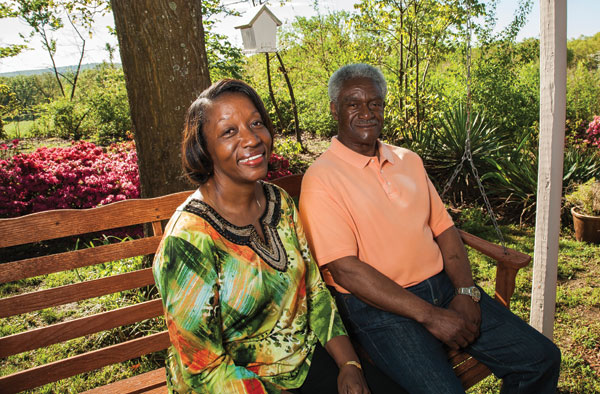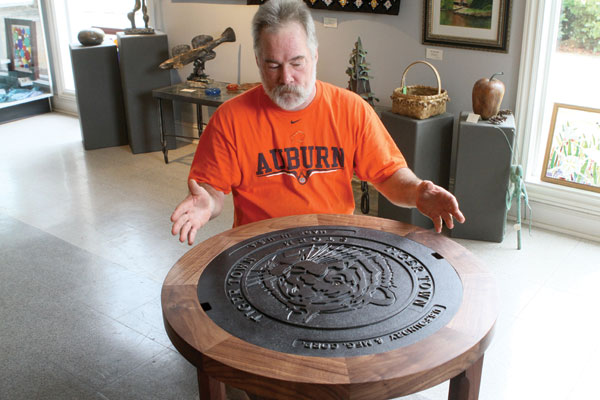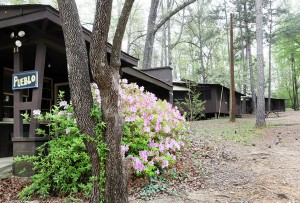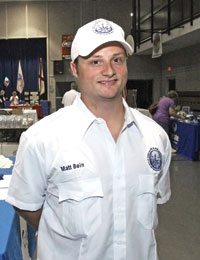Living in a work of art
Story by Elaine Hobson Miller
Photos by Jerry Martin
Jimmie Nell Miller is an artist and former interior decorator who likes to go to open houses and read Architectural Digest for the eye candy. But the Pell City home she shares with husband, Ray, is like eye candy to visitors, because its wide hallways, huge bathrooms and very modern kitchen are filled with Jimmie Nell’s colorful artwork. From tulips to Tuscany, cornices to credenzas, every inch of the Country French chateau reflects Jimmie Nell’s personality and her love for entertaining family and friends.
“It’s like an art gallery in here,” Jimmie Nell admits.
Atlanta architect Frank Jova designed this “art gallery,” which the Millers first spotted as a Southern Living Idea House in Chateau Elan outside of Atlanta in 1994. Jimmie Nell fell in love with its French influence, while Ray liked the way it flowed. Both appreciated the roominess of its 5,000 square feet, which may seem superfluous for two people. But Jimmie Nell says they use every square foot of it. “We entertain lots of functions, and have lots of family visits,” she says. “We live in the whole house.”
Built on a former dairy farm, the house is awash with European influences. Its wide hallways represent streets of old Europe, for example, and the extra depth of the tray ceiling in the entry hall is painted blue to keep the ghosts away. “It’s supposed to fool them into thinking it’s daytime,” Jimmie Nell explains.
The gallery tour begins in this entrance hall, where Jimmie Nell’s acrylic painting of Glen Coe, Scotland, one of seven inspired by her trip to that country earlier this year, rests on a stand. Her oil paintings of lemon trees flank the front door, along with sculptured fruits made of composite materials resembling stone, which she purchased.
Turning right, you come face-to-face with sunflowers and peppers in a red vase, done in oils, while the butler’s pantry features another oil painting of a rooster in bright plumage of blue, gold and red.
Kitchen cabinets are made of cherry, countertops are granite, and the appliances are Bosch and Kitchen Aid. The refrigerator is disguised as a tall cabinet, and an appliance garage hides the toaster, mixer and electric can opener. Bunnies nibble cabbage from a ceramic pot on the wall behind the gas range, thanks to Jimmie Nell’s ingenuity. She painted the tiles, then installed them herself because she didn’t trust the tile man to get the ears on the bunnies right.
“I designed my kitchen because I wanted the cabinets to look like little pieces of furniture,” Jimmie Nell says. “My cabinet maker said he’d build them that way, but he didn’t think I would like them. When he finished, he liked them, too.”
Pell City artist John Lonergan did the portrait of Ray, their son Adam when he was 12, and Adam’s dog that hangs over the fireplace in the den. That portrait and the 106-year-old watercolor duo by Ray’s great-grandmother that hang in the music room are among the handful of artwork in the house that weren’t done by Jimmie Nell.
 She has a glass table with eight upholstered chairs in her formal dining room, which she uses a lot. Her china cabinet, housed behind mahogany doors, holds Noritake china, cut-glass and redneck wine glasses (small Mason jars on stems). Jimmie Nell’s favorite piece of furniture is in this dining room, and it, too, features some of her artwork. It’s a bar made of two separate pieces that probably weren’t originally meant to be together. The bottom portion is a mahogany cabinet, while the top is a pine hutch with stained-glass tulips and a center canvas on which Jimmie Nell painted more tulips before installing it between the glass panels. “We bought this from an antiques dealer who used to be in St. Clair Springs,” she says. “We had it in our house before we moved here.”
She has a glass table with eight upholstered chairs in her formal dining room, which she uses a lot. Her china cabinet, housed behind mahogany doors, holds Noritake china, cut-glass and redneck wine glasses (small Mason jars on stems). Jimmie Nell’s favorite piece of furniture is in this dining room, and it, too, features some of her artwork. It’s a bar made of two separate pieces that probably weren’t originally meant to be together. The bottom portion is a mahogany cabinet, while the top is a pine hutch with stained-glass tulips and a center canvas on which Jimmie Nell painted more tulips before installing it between the glass panels. “We bought this from an antiques dealer who used to be in St. Clair Springs,” she says. “We had it in our house before we moved here.”
Another painting of tulips, this one in acrylics, hangs between the dining room and music room, because “tulips are easy to paint,” says Jimmie Nell. She has had the room’s baby grand piano more than 40 years and believes it was built in the 1930s. While neither she nor Ray play piano, their two daughters, one son-in-law and a granddaughter do. Nevertheless, the music room happens to be her favorite, the place where she loves to curl up with a good book or take a nap.
From the screened porch off the dining room, the sound of ceiling fans overhead and an Italian bronze garden fountain outside soothe the soul. The peaceful garden features knock-out roses, daylilies, limelight hydrangeas, magnolias and blue point juniper spirals. Both Ray and Jimmie Nell work in the garden, but Ray, a retired banker, trims the 10-year-old topiaries himself.
Back indoors, the art tour continues down the hall from the entryway into the powder room, where Jimmie Nell has an old credenza on which she depicted parrots, monkeys and a leopard “back when jungle themes were so popular.” Nearby is the media room, where a 72-inch wide-screen TV is set into a niche in one wall. Movie posters of John Wayne and Clint Eastwood adorn other walls and a bronze replica of Remington’s Mountain Man dominates the center. Two leather couches and four mission-style gliding rockers with fake-leather bottom cushions and Southwestern-print back cushions provide ample seating. Jimmie Nell made the glider’s back cushions and the room’s matching cornices herself. The media room happens to be Ray’s favorite in the house, a place where he keeps up with the news and email via television and computer.
The master bedroom is near the media room and features another tray ceiling, a portrait of Jimmie Nell done in 1986 by Pell City artist Evelyn Whatley, and a huge bathroom with his-and-hers sinks and vanities on opposite sides of the room. The vanities are separated by a glass-enclosed shower, and Ray and Jimmie Nell have separate closets, too. More of Jimmie Nell’s artwork is featured in a buffet from her old dining room suite that has panels she painted with shell designs.
 Upstairs are two guest bedrooms, one with a 100-year-old washstand on which Jimmie Nell painted a Colonial couple at a fence, and a doll house made from a kit one of her daughters gave her 20 years ago. An open balcony connects the two bedrooms and overlooks the dining room on one side, with a glass-less window overlooking the entry hall on the other.
Upstairs are two guest bedrooms, one with a 100-year-old washstand on which Jimmie Nell painted a Colonial couple at a fence, and a doll house made from a kit one of her daughters gave her 20 years ago. An open balcony connects the two bedrooms and overlooks the dining room on one side, with a glass-less window overlooking the entry hall on the other.
In the second upstairs bedroom Jimmie Nell used French toile for the bed’s coronet and a chair skirt, but a nautically-themed fabric on the bed pillows and valance.
After 12 years in the house, the Millers still find it very livable. “We like the way it flows,” says Ray. Jimmie Nell agrees. “I like the roominess of it, and the private areas where we can get away from each other,” she says, with a wink. “That has probably saved our marriage.”















































































